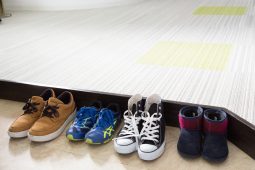In this article we will look at some practical information and common terminology that will help you navigate the apartment rental process in Japan.
In Japan apartments are usually called either アパート (apaato) or マンション (manshyon). The word アパート tends to refer to apartments in smaller buildings of two or three stories, and マンション tends to refer to those in taller buildings. However, this difference is not so strictly defined.
The best way to find a new apartment is through a 不動産屋 (fudōsanya) real estate agent. It is a good idea when searching for a new place to try a few different agencies as that will give you more options. Unless you are very confident in your Japanese language skills, you should also bring along someone who can interpret for you both during the initial search and when formalizing a rental agreement.
Japanese apartment listings have some special terminology. The 間取り(madori) or layout of the room is usually written using the abbreviations L, D, K which stand for Living Room, Dining Room and Kitchen. The number that precedes these letters tells you the number of rooms. Here are some examples:
1 R = One room, basically a studio apartment with a small kitchen area.
1 K = One room with a separate kitchen.
1 DK = One room with a separate kitchen and dining area.
1 LDK = One room with a separate living and dining area, and a separate kitchen.
These abbreviations exclude other areas such as the bathroom and toilet, the balcony, and the entryway, but these will all be visible on the floor plan.
Regardless of whether rooms have tatami or wooden flooring, room sizes are often measured by how many tatami mats they can contain. The standard size for a tatami mat is 180 x 90cms, and mat size is written as 畳 (jō), but is sometimes abbreviated to “J”, so “6J” would mean a 6 mat room.
Having decided on an apartment you may need to pay an initial 手付金 (tetsukekin) deposit so that the apartment is reserved for you before the lease is signed. This will probably be around one month’s rent and is refundable when you sign your lease.
In order to lease an apartment you will need:
* Your passport and Residence Card.
* An officially registered 印鑑 (inkan) seal.
* Proof of income.
* A 保証人 (hoshōnin) or guarantor who can provide surety if you should suddenly be unable to pay your rent. If you don’t have any personal contacts you may be able to ask your employer to fulfil this role. If neither of these are available to you, then you can use a guarantor company, but this will incur you extra expense.
In addition to the 家賃 (yachin) or rent, there may also be additional regular maintenance fees called variously 共益費 (kyōekihi) or 管理費 (kanrihi). Quite often though, these expenses are already included in the rent.
Unfortunately, the initial outlay when you rent an apartment is often quite steep and may include some or all of the fees listed below:
* One or two months’ rent in advance.
* A security deposit called 敷金 (shikikin) which can be equivalent to one or two months’ rent.
* A nonrefundable gratuity to the landlord which is often called “key money” in English and called 礼金 (reikin – literally “thanks money”) in Japanese. The equivalent of one month’s rent is normal for this but it may be more.
* A handling charge to the estate agent called仲介手数料 (chuukai tesuuryou) which may equal half a month’s rent or more.
* Damage insurance called 損害保険 (songai hoken).
In theory the shikikin is a returnable deposit against possible damage to the apartment, but in reality this money is rarely returned.
Most apartment leases are for two years after which if you want to stay in the apartment you will probably need to pay a 更新料 (kōshinryō) or renewal fee. This too can be the equivalent of one or two months’ rent.
Rental apartments are usually unfurnished but you can usually pick up a lot of essential household appliances and furnishings cheaply at a local リサイクルショップ (recycle shop).








